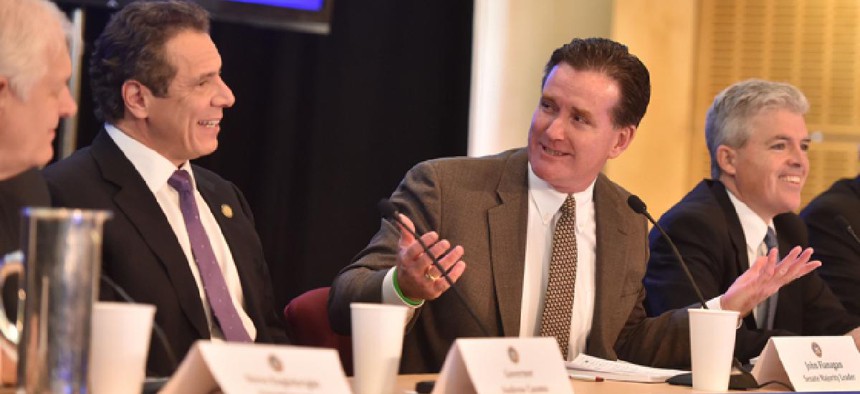Following the Campaign for Fiscal Equity court decision in 2006, which ruled the state was failing to provide students with funding necessary to receive a “sound basic education,” education advocates rejoiced and hoped the decision would bring a new, better age for the way New York State funds education.
It didn’t turn out that way. The state increased school aid to confront the problem over the next two years, but in 2009, as a result of the Great Recession, the additional school aid under the CFE decision – called foundation aid – was frozen. The state also created the Gap Elimination Adjustment, or GEA, that same year to help close the state’s budget deficit. Then in 2011, Gov. Andrew Cuomo instituted a property tax cap that limited spending growth in school districts.
“State aid is obviously a very important component for all school districts, but particularly for lower-wealth districts, because they can’t raise as much money on property taxes as say a wealthier district,” said David Albert, communications director for the state School Boards Association. “Districts don’t always have the capacity to raise sufficient funding locally to support their education programs and obviously we got off track with foundation aid with the recession and then the GEA being put in place, but I think that we’re kind of turning the corner now.”
Indeed, many education experts see the 2016-17 budget as a potential turning point for education funding in New York. The state is in much better fiscal health, and the recent multimillion-dollar bank settlements, they believe, create an opportunity for the state to finally make good on failed promises to better fund the education system.
In his executive budget this year, Cuomo has proposed a $266 million increase in foundation aid. Additionally, Cuomo has proposed the elimination of the GEA over a two-year period, allocating $189 million for this year’s budget. The total school aid increase in the governor’s budget – including the foundation aid, funds to close the GEA and other funds – is $991 million, raising it 4.3 percent to a proposed $24.22 billion.
The state Senate proposed a larger increase of $1.6 billion, while the Assembly proposed a $2.13 billion increase.
In their one-house budgets, both the Assembly and state Senate called for the elimination of the GEA in one year.
State Senate Majority Leader John Flanagan, who formerly served as chairman of the Senate Education Committee, has long championed the elimination of the GEA. In January, Flanaganinsisted there would be no budget deal without the full elimination of the GEA this year.
“I am very confident and comfortable saying as chair of the Education Committee for five years and now working very closely with Sens. LaValle and Marcellino, who chairs our committee, the New York State Senate Republican conference has been out front on the elimination of the GEA since the get-go,” Flanagan said on the state Senate floor this month. “We didn’t support it at its inception, we have been pushing and pushing and pushing and – yes – pushing to make sure we get rid of it.”
The state Senate one-house budget also allocates $880 million for an increase in foundation aid and the Assembly one-house budget allocates $1.1 billion for foundation aid. Both houses are trying to catch up to spending promised under the foundation aid formula, which they estimate has $4.4 billion remaining in funds that were promised as a result of the CFE decision but were never spent.
“(The foundation aid increase) is a very important difference between the Assembly and Senate proposal. The Assembly has a four-year phase-in so that schools can get the money they need,” said Billy Easton, executive director of Alliance for Quality Education, an advocacy group closely aligned with the Assembly Democratic conference. “Neither the governor nor the Senate has made that commitment and we need that commitment and we need it in this budget now.”
A recent audit conducted by state Comptroller Thomas DiNapoli’s office found the state should improve its education aid formula and provide more equitable funding for schools. In the report, DiNapoli also urged lawmakers to adopt a more equitable and transparent funding model.
“As stakeholders undertake planning and negotiation for the upcoming budget, there is an opportunity to work towards a simplified, more equitable and transparent model for funding education in New York state,” the report said.
Education advocates said if the state fully funded the foundation aid formula and closed the GEA this year, school districts around the state would be in a significantly better financial position.
“There are 20 different ways that you could change the way public schools are funded, but at the end of the day the only number that matters is the final school aid number,” said Carl Korn, chief press officer for NYSUT, the state teachers union. “There have been many proposals over the last few decades on how to change how schools are funded. It would be a little flippant to say we don’t care how they’re funded, but at the end of the day, what’s most important is that our public schools are funded properly to ensure any child – no matter their zip code – has an equal opportunity to succeed.”
Albert also said the state aid component is critical because it’s difficult for school districts to exceed the state’s property tax cap, noting that districts can only override it with a 60 percent supermajority.
“So, where are they going to get the money to support the educational programs if they can’t raise it through local property taxes?” Albert asked. “It’s going to have to come from the state.”


